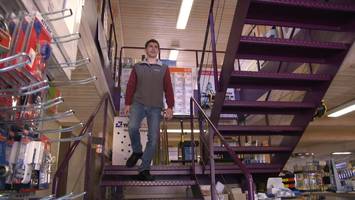Sciatic nerve irritation can develop quickly. The slightest movement can trigger irritation. Even a fast
clumsy movement can pinch the sciatic nerve and cause sudden pain. Typical symptoms of sciatic nerve irritation include severe pain in the lower back in the lumbar part of the spine that may occur as a dragging pain down to the buttocks and the leg, severely restricting movement.
kybun relieves the back when you have acute pain, helps the body walk upright again and prevents relieving postures. The spinal column and back muscles are gently mobilised, thereby reducing pain and tension.
The
sciatic nerve (Nervus ischiadicus) is the most powerful peripheral nerve in the body. It originates from the groin-sacroiliac joint-plexus (Plexus lumbosacralis), which emerges in the area of the third lumbar vertebra (L3) up to the first three sacral vertebrae (S3) between the vertebrae from the spinal column. As a peripheral nerve, it is responsible for
motor supply to certain hip, thigh and calf muscles through arborisation. This means that it transmits deliberate signals to contract or relax specific muscle groups, thereby enabling conscious movements. These are stimuli from the brain to muscles. The sciatica also has sensitive nerve fibres that report
sensory impulses like pressure, heat, pain, contact etc. in the surface area of the enervated muscles to the brain. These messages are involuntary, meaning they are not subject to will. The sciatic nerve is required to voluntarily move the muscles that it enervated and to forward sensory feedback that happens automatically (involuntarily) to the brain. This way, the brain can take any necessary action to avoid damage. On its way from the Plexus lumbosacralis, the nerve has to bypass
multiple narrow points that can result in impaired stimulus transmission in both directions due to tensile or compressive stress on the nerve.
The nerves in the lower back exit from relatively narrow openings in the
lumbar spine.
Muscle contractions or
wear to the intervertebral discs or vertebral bodies can cause a trapped nerve. If the sciatic nerve is affected, pronounced pain, tingling or sensation disorders are felt along the leg. However, this particular nerve can also become pinched, leading to severe distress. For example, the gluteal muscle can pinch it at the upper end of the thigh.
The worst thing about sciatica is that disorders often do not occur at their point of development, in other words, where the nerve is affected. Rather, they occur much lower down in the leg. As a result, the lower leg may feel numb on one side or an uncomfortable tingling or a cotton-wool feeling spreads in the foot.
If the nerve suffers irritation or damage at the root, it can also result in
symptoms of numbness and paralysis along the leg. Ultrasound scans and X-rays can be used to quickly determine where the pinched nerve is located and where the sciatic nerve irritation has developed.
Seek immediate medical attention in the event of
neurological problems or
disorders in internal organs such as the bladder and rectum.
Prevention:
It is possible to prevent sciatica problems by
regularly participating in sport, avoiding
sitting for long periods and in the incorrect position,
doing specific back exercises and
walking a lot.
Treatment: - Rest and recovery is recommended until the sciatic nerve irritation has subsided. Afterwards, the aim is to conduct targeted, regular exercise to strengthen the back muscles. Under the supervision of a physiotherapist, physiotherapy can be used to learn special sciatic nerve exercises so as to reduce sciatic nerve irritation for good and strengthen the back muscles.
- Muscle-relaxing massage
- Pain relieving medications:
Cortisone and local painkillers such as diclofenac may be injected as an emergency measure against sciatic pain. In addition to pain relief, these medications relax muscles and have anti-inflammatory effects. - If the vertebral bodies are blocked, a chiropractor can usually provide assistance.
- Heavily degenerated intervertebral discs (wear) result in more frequent sciatic nerve irritation, in which case only an operation can provide relief. The same applies in the event of ongoing symptoms of numbness and paralysis, neurological problems and disorders in internal organs such as the bladder and rectum.
The kybun principle of operation – be proactive
In the
acute stage, the soft, elastic kybun shoe sole/kybun mat absorbs the impact on hard ground, thereby reducing stress on the sciatic nerve. Pain is reduced and the nerve is able to recover.
In the long term, exercising the body with kybun becomes possible every day without expending additional time. This is the best way to
prevent back problems such as sciatic nerve irritation.
The kybun mat/kybun shoe ensures you automatically stand
more upright, which protects the joints. This reduces relieving postures and limping.
The natural rollover movement of the foot
strengthens it and enables it to assume its shock-absorbing and force-balancing function once again. This not only protects the overlying joint such as the knee and hip, it also protects the back.
The upright posture relaxes the superficial back muscles which are prone to strain.
Tension pain and joint blockages are reduced and the intervertebral discs and back joints are subject to less wear.
Back joints and muscles are gently moved all day on
the soft, springy kybun shoe soles and on the kybun mat without straining them. Muscle tension and joint blockages, which often result from remaining in an awkward body position for a long period or overstraining, cannot build up in the first place.
Gently moving the vertebrae and relaxing the back muscles helps the ‘pinched’
sciatic nerve to recover, because it has more space in the narrow points again and is no longer pinched.
The sciatic nerve is also relieved through the upright posture and by
exercising the deep, stabilising back muscles.
- The core, stabilising musculature of the spinal column is strengthened on the soft, springy kybun surface, which in turn serves to stretch the intervertebral discs. This relieves and simultaneously stabilises the back. The irritated nerve is relieved and can gradually regenerate. The feeling of numbness (toes going to sleep) should decrease over time.
- Activating the core, stabilising musculature also stimulates deep circulation and therefore promotes healing after an injury.
Click here for the general initial reactions experienced by kybun mat and kybun shoe beginners:
Initial reactions
Specific initial reactions with back problems/sciatic nerve irritation:
If you are not yet accustomed to the kybun shoe/kybun mat and suffer from back problems or sciatic nerve irritation, the radiating pain may worsen slightly at first. In this case, it is important that this initial reaction disappears again as quickly as possible since neurological pain is very unpleasant and we do not want to further stress the affected nerve. In this case, please observe the ‘Application tips’ below and seek advice from your kybun dealer if your condition does not change within a few days.
For information about the special kybun shoe exercises or the basic kybun mat exercises, please click here: kybun exercises
If you experience back pain in the kybun shoe or on the kybun mat or if your familiar back pain gets worse (for example, radiating pain), this may be due to various reasons (such as tense muscles, movements that are unfamiliar for the back, increased pressure on the intervertebral disc).
We advise you to perform the
kybun exercises regularly every now and again. They loosen the muscles and straighten the body. The strain on the back and especially the intervertebral discs is relieved. The radiating pain should decrease after just a few hours or days.
Choose a kybun shoe with a
lower rebound effect. This gives you more stability in the midfoot. Have a kybun dealer show you various models.
If you feel unstable wearing the kybun shoe or are looking for an additional training device to use at home, the
kybun mat is the ideal alternative. You can strengthen the foot, leg and back musculature at home on the soft, elastic springy mat. You can hold on to a fixed object if you feel unstable. The kybun mat is also available in a choice of different thicknesses (the thicker it is, the more intensive the training). Ask your local kybun dealer for advice.
If you get very fatigued in spite of the kybun exercises, or if you feel pain or in case of lateral/medial rolling of the ankle joint on the kybun sole, we advise you to take a
short kybun shoe/kybun mat break until the symptoms go away.
Be sure to maintain an
upright posture, avoid taking
excessively long steps and
keep your gaze forward (do not look at the floor). You should walk straight on the kyBoot sole and
correct any lateral/medial rolling of the ankle joint!
If the radiating pain or the feeling of numbness does not go away,
seek advice from your kybun dealer.
Opinions/customer testimonials







